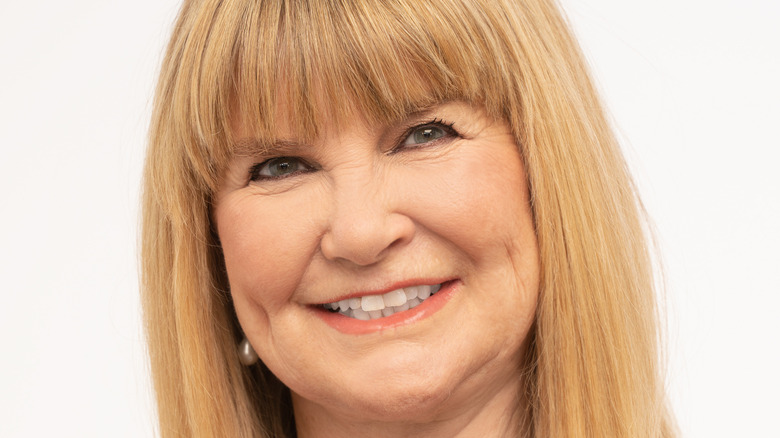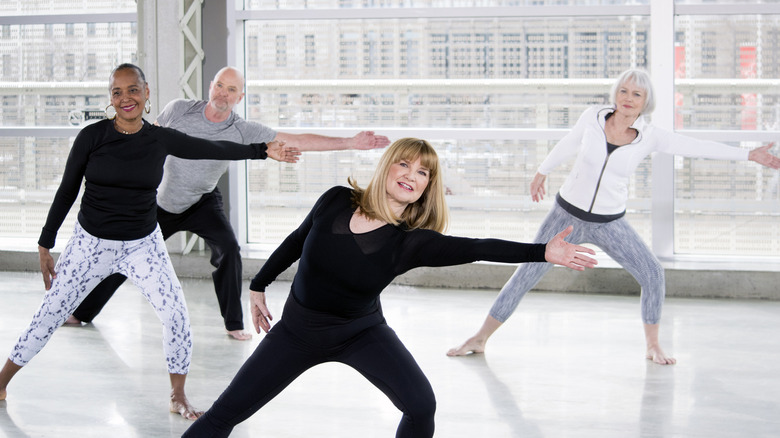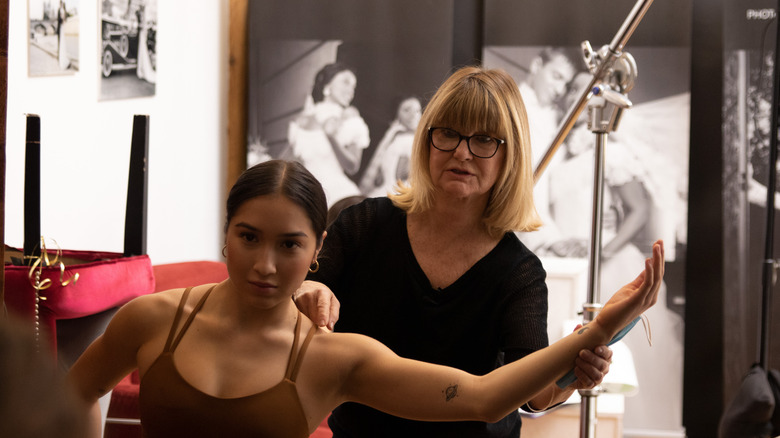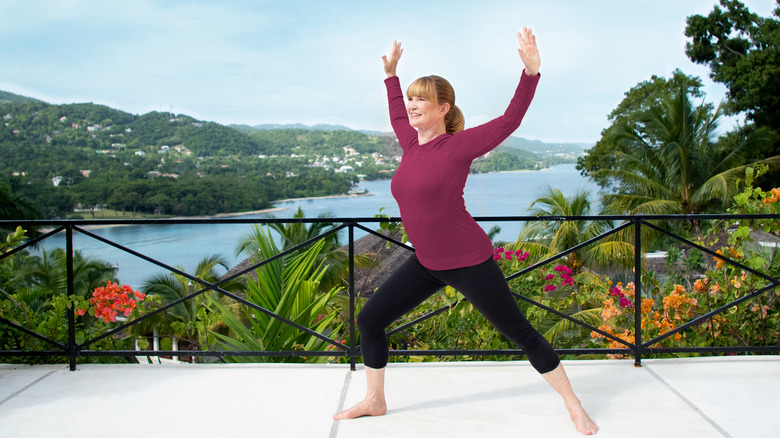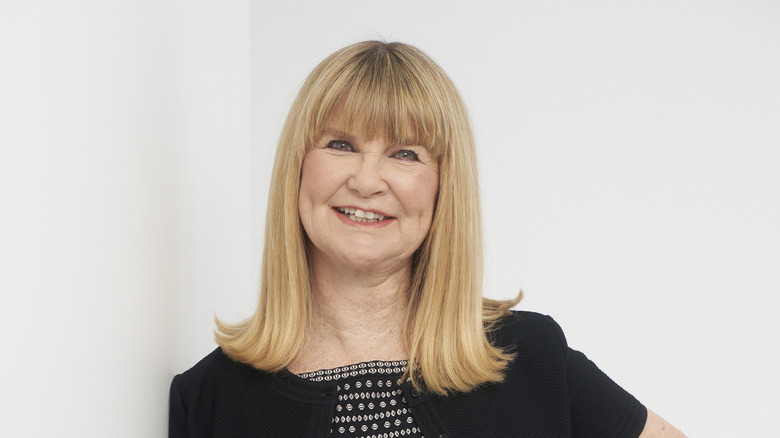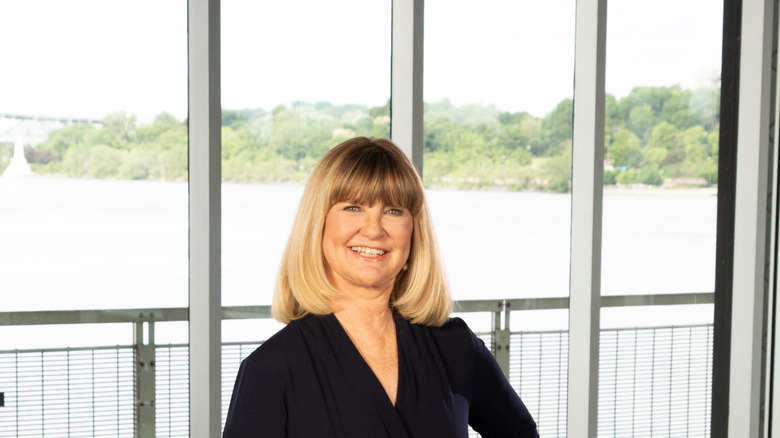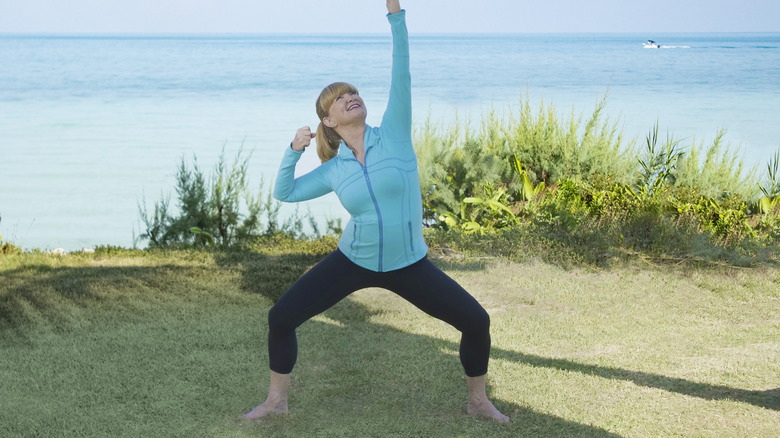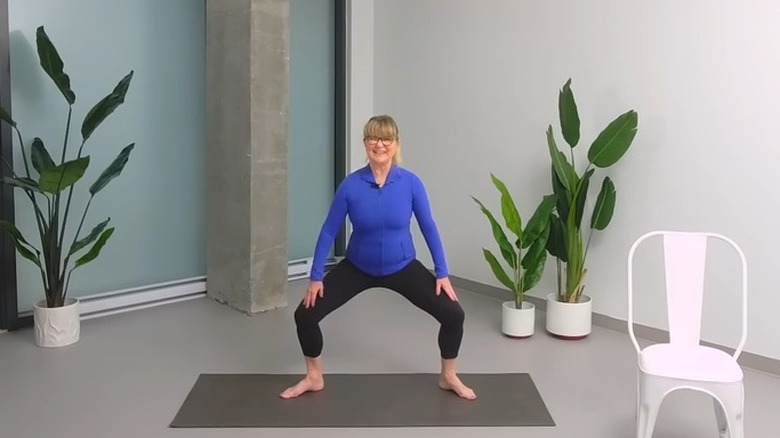PBS Star Miranda Esmonde-White Explains The Miracle Of Flexibility - Exclusive Interview
Since 1999, PBS viewers have faithfully tuned in to Miranda Esmonde-White's fitness show, "Classical Stretch." A dancer with the Canadian National Ballet before pivoting to a career as a fitness instructor, Esmonde-White has never taken mobility or fitness for granted, and over the course of her career, she became increasingly interested in the connection between flexibility and general fitness.
Her research into this area led her to develop her signature fitness program, Essentrics, which features gentle stretches designed to cultivate proper body alignment and a full range of motion in all joints. Since then, Esmonde-White has introduced Essentrics to everyone from formerly sedentary seniors to elite athletes, who have all experienced enhanced flexibility and reduced pain and stiffness after adopting the program. "Classical Stretch" introduced Essentrics to a wider audience and earned it a loyal following.
Her latest book, "The Miracle of Flexibility," is a comprehensive guide to Essentrics and is intended as a reference guide for both experienced practitioners and those new to Essentrics. In this exclusive interview, Esmonde-White shares her fitness journey.
Essentrics evolved from a desire for a pain-free workout
You are best known for the Essentrics workout. Could you explain exactly what that is and what sets it apart from other workouts?
Twenty-five years ago, I started creating this program. I owned my own dance and fitness center. I'd owned it for 20 years. In the program, we were offering aerobics, all the step aerobics, and all the weights and stuff like that.
We all started together in our 20s, and as we were reaching our 40s, a lot of my clients were saying there were aches and pains [and] their bodies are changing [and] compressing. They want to look lean, like ballet dancers, and they want to have a good workout, but some of them were suffering from knee pain and back pain. I had chronic back pain also, and I just assumed, "This all comes with life. This all comes with aging." You assumed this is natural progress. And they wanted something gentler.
So I started to study the human body. What is the perfect human body? What is the human body created to do?
I noticed that the human body is designed to move. That's what it does. It's supposed to move in every single direction: up, down, twist, turn, bend. Fingers have their range of motion. Shoulders have theirs. The signature of aging is when they can't move so easily. The signature of youth is this incredible ability to move with ease.
The balance between the two fascinated me when I was in my 40s. Why is this stiffness, this locking down of the body? What's causing that? Everybody said it was aging, but I wanted to know what that meant.
Over [the] decades, there's been many archeological digs and anthropologists discovering perfect specimens of thousand- and tens-of-thousand-year-old bodies that are in perfect shape. Their joints were in perfect shape. They figured the people were in their 80s, 90s, 100s and yet they still had healthy joints, had healthy mobility.
That proved that the human body is not destined to lose its mobility, not destined for people to have hip replacements, and not destined to age the way we do, where we get stiff and can't move so easily. I wanted to know how to do that. How do we make everybody stay that way all their lives? How can we prevent this stiffness from happening?
Here's why bulking up your muscles is a bad idea
It evolved into full-body stretching and strengthening of all 650 muscles. Every muscle in the body has to be equally balanced, properly aligned. Nothing can be overwhelming something else.
If you do a lot of weights, for instance, and you overbuild your pectorals, or you overbuild your trapezius muscles, they're going to round your back, and then you're not going to be able to move your arms properly. They won't go up. So you lose the natural range of motion in those arms, which will affect right down your body, spiraling down into your chest, your lungs.
To have the full range of motion, you need to have the pectorals strong [and] the trapezius strong, but not one overwhelming the other — the deltoids strong, but not overwhelming anything else. That was the beginning of understanding that a body has to be equally strong and flexible — not one element overpowering the other element.
I realized we're looking at the body all wrong in the fitness industry. As fitness people, we should be looking at the body as a whole, not as pieces. We're moving not [just] muscles ... When I move my arm, I'm moving my bones, my muscles, and my connective tissue. But we're always thinking [of only] muscles. We've not thought, "What's actually going on?" It's three systems: the muscles, the bones, and the connective tissue. Each one of them is totally different and separate from the other and yet totally intertwined and dependent on the other.
The connective tissue, which is fascia, lymph, ligaments, tendons, cartilage, and discs — without [that], everything would fall to the ground. The bones would have nothing to work with. The muscles are encased in fascia. Every cell in our body is encased in fascia — trillions of cells. They're encased in a little coating outside and a little coating inside. And all the nutrients from the lymph system have to go in through the connective tissue and the bloodstream. Everything goes in, and it all feeds out.
The connective tissue, the muscles, and the bones have to be worked together, not separately. If you forget the connective tissue and you're only thinking muscles, you could overbuild the muscles and cause what's called wadding, or atrophying, or dehydrating, of the unused muscles.
You know when something won't move? It won't move because that's connective tissue that's dehydrated, or shrunk, or blocked, or caused wadding. Connective tissue has a lot to do with aging, and immobility of young people, like athletes who can't move. They're pushing their muscles, but it's actually their connective tissue that's the issue. They have to work the full trifecta in order to get the liberated, powerful body.
Esmonde-White rejects the celebration of pain in athletic culture
You mentioned that a lot of serious athletes get into trouble by working out wrong. What are some common mistakes that people make when they're trying to stay in shape, people who'd like to think of themselves as very fit?
One of the reasons I wrote this book was that I wanted to change the way people think of exercise. You've got your sedentary people, and you've got your people that love exercising.
People who start exercising usually go to some kind of gym at some point in their lives, and they're pushed hard. No pain, no gain. You just keep going. [That] mantra has been in the fitness industry for decades, and I would even say for centuries because when we look at gladiators [and] the way the world approaches people who go to the extremes, we admire that. We think, "Wow. That person's hot. That's the body I want."
I work with many, many high-performance Olympians [and] world champions. I was with the National Ballet of Canada. Ballet is a high-performance sport art. All of those push your body to its limits, and if you want to succeed in them, you have to be able to withstand a tremendous amount of pain and love going to your limits.
I did. I loved ballet. Yet I remember in Seattle once doing "Swan Lake" and leaving a trail of blood across the stage because my feet were infected. I had so many blisters, and my toes were infected. As [I was] doing those little bourrées across the stage, I left a little trail of blood. But I could handle it. You learn to withstand pain, but it doesn't mean it's good for you, and it doesn't mean it'll keep you young.
People when they're young want to exercise because they think they're going to look great. Young people should actually take a look down the road at the people in their 50s and 60s and see what they look like. Will you still look and feel great as you get older, as you get into your 50s, 60s, 70s, and 80s? Or are you going to be on painkillers, which so many people are, chronically in pain from needing knee replacements, hip replacements?
High-performance athletes, someone like Tiger Woods, who I adore — before he was 40, I think he'd had seven or eight spine surgeries. That's insane. Poor man. He's in pain. Why should we do that?
World-class athletes have benefited from Essentrics
From your perspective, knowing what you do now, what would you have told Tiger to have done differently?
I would've trained him differently. When I work with athletes now, which I don't do that much, because I'm doing so much writing books and TV shows, but I work with the people who work with them ...
I worked with — for about 10 [to] 12 years — the world squash champion, and he still does our program. He's now 48, but when he started when he was 23, he was chronically in pain, and his career was finished when I met him. He'd already been the world squash champion twice, so he was right at the top, but by the time I met him, he had an inflamed ligament. Every time he would lunge, it would reignite the inflammation, so he couldn't finish a competition. He couldn't get into the preliminaries, because he was chronically injured for nine months.
So we started training [with] very simple exercises, feet exercises. His feet didn't move. Most athletes' feet don't move. You take their shoes off, and [you see] their feet don't move. Their toes don't move.
I worked with Joannie Rochette, who won bronze [in figure skating at the Olympics] in Vancouver. I worked with her for [about] eight years before that, getting her to move her feet. Skaters [and other] athletes — their feet are locked in shoes, so most athletes' feet become immobile. What happens to something that's immobile? It starts to atrophy. Everything from the feet up starts to be affected and weakened.
For Esmonde-White, pain is a useful diagnostic tool
What would you recommend to someone coming into the new year who's never worked out before [and] who's saying "This is my year to get fit"? How would you recommend that they get going?
This book is it. I originally called it "The Stretch Bible." It's got 62 workouts in it. I would recommend people look for what they need, and they've got all the descriptions of how to do it all. Photocopy [the workouts and] put them on the wall. There's [workouts] for everything you'd possibly need in terms of getting into shape. ...
When I started to study, [I realized] pain is a message telling us something is wrong. It's a message telling you, "You've got a cut on your face," "You've broken your leg," "You've been in surgery and your body's in pain," or "You've got the flu." The message of pain [is] "Fix this." It doesn't mean, "Push through it. Make whatever's injured more injured."
It's stupid, what we've been doing. You don't want to destroy your body. You want your body to last until you're 100 [so] you can still bounce around and enjoy being an athlete, but not a super athlete. Just enjoy your life, be pain free, be fully active, do all the things you want to do, have good posture.
I'm 73, and I have lots of energy and I've got good posture. I can go through a day without being worn out. Sedentary people get tired so easily. You don't want that. You want to live vibrantly throughout your life.
We have to change our attitude and stop admiring pain and start recognizing the incredible gift that our body has given us [when it tells] us that we have pain. ... All we have to do is stay aligned. All we have to do is keep this gentle range of motion going in all our joints.
I'll wake up in the morning one day, and my foot hurts. So I do a few little foot exercises, and the pain's gone because I understand that you just need to realign it. Do a few little exercises, very, very little, and the pain will disappear. Pain is like your private doctor.
These exercises, this whole program — it's so gentle. The concept [is] "Don't go in pain, and don't accept pain. Do not accept chronic pain." Yes, we will have pain. For sure, we will have pain. But chronic pain is something that's mechanical. It can be fixed through rebalancing all the joints.
Improving your flexibility will also improve your strength
Your book is called "The Miracle of Flexibility." Can you briefly explain why flexibility is the key to fitness for you?
If I said, "the miracle of strength," everybody would go to their extremes. They have to think, "flexibility — why flexibility?"
If you can move every joint in your body in its natural range of motion, what's your potential? You should be able to straighten your elbow with your arm above your head, with your back straight behind you, and do a rotation. Your arm should be able to do that. That's the range of motion.
Flexibility is [a] range of motion. But it takes strength to get your arm there. A lot of people don't have enough strength to do some exercises holding their arms up; they're too weak. If you work on your range of motion, then you will automatically get the equal strength that will balance what you need.
I don't have to lift a weight in order to get my arm up. All I have to do is work on this. That's what flexibility is. If you [have] the flexibility, then you will have exactly matched strength. The two will come together. You don't have to then think about strength.
Fans of her show, Classical Stretch, say it's changed their lives
You have a show on PBS, "Classical Stretch," and it's been on for quite a while. Could you share a little bit about how that's evolved over the years?
It started off in 1999. That was when I first went on the air. And now we're on, I think, 98% of all PBS stations. There [are about] 270 stations across the country, and we're basically on every station.
When they pull us off the air for whatever reason, the viewers phone in and say to put back their workout. You might not mind missing some show[s], but you do mind missing your workout. They're half an hour a day. If you do it every day for a month, your life will change if you're in pain. The pain slowly goes away.
Sometimes in the office, when these [emails] come in, we're all — 10, 15 people — sobbing at the stories that come in [about] how people's lives change. Forty-year-old people think that their life is finished and they'll be dead within the year, and they're writing to us about [how] their whole life has changed. This is five years later, and they're bouncing off the walls with life.
I love interviews like yours because I'm on a personal mission. [I'm] helping people restore their own bodies to them, to the beautiful body that it's meant to be. It's returning it to itself. It's nothing crazily wild, but when you have your body back, you have your whole life.
There was one girl [who] was 32 or something. She came to one of these retreats of ours. Her mother brought her. She was the mother of three young girls, and she was on every drug you could name. And she really thought she was going to die, and she didn't want to be there.
At the end of a week of doing two classes a day, she was already off some major drugs and her whole life had changed. She gave a talk to the group, because there were 100 people at that event, and they all got to know her over the week. I asked her to tell everyone [about her experience]. People need to know because they can tell their neighbor who's in pain like that.
And she is not alone. You just have to watch the TV to see how many ads there are for drugs because there's so many people in pain. They need help, and a fitness program like this, which is so gentle, can make an amazing difference. Get your body back.
You can pre-order "The Miracle of Flexibility," by Miranda Esmonde-White, available February 28 from S&S/Simon Element. And tune in to Miranda's new special on PBS, "Aging Backwards 4: The Miracle of Flexibility," from February 25 to March 12.
This interview has been edited for clarity.

